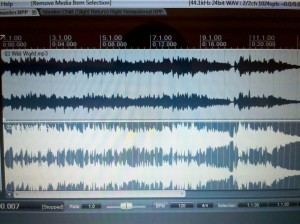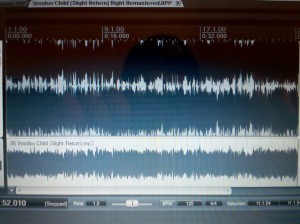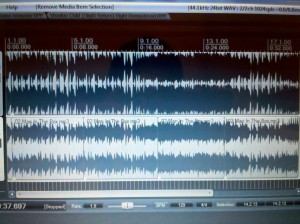Background:
Compact discs have permanently changed the way people listen to, store and record music. Though the uses for them have expanded since their initial release in the late 1970’s and their popularity has declined considerably since the invention of the mp3 and related music players, they are solely responsible for the digital music revolution. Analogue music recorded on vinyl records had its own advantages and disadvantages. Of the most concern here is a portability and shock resistance issue that simply could not be overcome due to the method of encoding and reading used to store the audio information on records. Compact disks overcame both of these issues, though the differences in data storing allowed for new approaches to mixing and mastering recordings. These mixing and mastering trends in turn have changed people’s preferences for recording style. People have come to expect certain qualities from the audio they listen to, qualities which often were not present on recordings made decades ago. Thus, when songs are rereleased, they are often remastered to cater to more current acoustic preferences.
Due to the physical limitations of needle vibration within the grooves of the record, an inherent volume limit to recordings was imposed on records. However, even during the days of turntables, louder recordings tended to attract more attention in situations where sound quality was not as apparent (radio/ jukeboxes). Thus, recording studios would make their recordings as loud as possible in much the same way that television stations tend to make the commercials louder than the actual program. People have a tendency to equate louder music with higher quality recordings (a tendency supported by our testing. Many of our subjects stated that one side sounded better simply because it was “louder”). Upon the introduction of the compact disk, this physical limitation was removed allowing for much louder music. The change wasn’t immediate. It took many years.
Rather than merely upping the volume of the entire track, a practice called compression is often used. Compression takes the quietest sounds and makes them louder while softening the louder sounds. Because it is easier to more clearly discern louder sounds, people will often equate better sound quality with a song that has less dynamic range. You can more easily hear softer sections of music in a more compressed track. Ironically, compact disks were marketed for their potential for greater dynamic range (complete silence could be achieved as no needle noise is involved). However, such changes to audio after it is recorded can cause distortions or clipping. The most drastic changes to audio compression trends occurred between 1990 and 2000.
We set out to test whether the volume itself was the source of perceived increase in musical recording quality over the years, or if the clipping and distortion caused a significant decrease in perceived quality when volume was adjusted for.
Song Info
We used six recordings for our preference test. Two recordings were for each song. One was from an original album release and a second was from a remastered version from a “greatest hits” album released years after the original album. The first song was Wild World by Cat Stevens. The original taken off the original release of the compact disk of Tea for The Tillerman and the remaster taken from The Very Best of Cat Stevens released in 1990. Second song was Voodoo Child (Slight Return) by Jimi Hendrix. The original was taken from Electric Ladyland (rereleased in 1993) and the remaster taken from Experience Hendrix: The Very Best of Jimi Hendrix released in 1997. The final song was Man in the Box by Alice in Chains. The original was taken from Facelift released in 1990 and the remaster taken from Greatest Hits released in 2001.

Image 1: Song 1, Wild World. The bottom track is the remastered song while the top track is the original compact disk release. Greater amplitude is equivalent to louder sound. Audio clipping is less apparent on both of these tracks. Compression is evident on the remastered track.

Image 2: Song 2, Voodoo Child (Slight Return). The top track is the remastered song while the bottom track is the original compact disk release. Greater amplitude is equivalent to louder sound. Audio clipping on the remaster is clearly visible as is the compression on both tracks.

Image 3: Song 3, Man in The Box. The top track is the remastered song while the bottom track is the original compact disk release. Greater amplitude is equivalent to louder sound. Significant compression as well as clipping is visible on the remastered track.
Preference Data Summary:
As stated in earlier posts, we tested personal preferences for different recording styles. We asked subjects to rate each sound clip on a scale of 1 to 10, 10 being the highest on sound quality while using adjectives to describe the differences between the clips (within and between songs). Our hypothesis was not supported by our data. The average rating for the original recording was lower on two of the three songs we tested. Not only that, the preference towards the original or remaster was in favor of the remaster for the same two songs. The average rating for the original Wild World recording was 6.025 while the remaster averaged 6.275. The average rating for the original recording of Voodoo Child (Slight Return) was 6.925 while the remaster averaged 5.375. The original recording of Man in the Box had an average rating of 6.425 while the remaster averaged 6.75. When attempting to compensate for personal differences in audio quality scaling, the average of the differences between original and remaster was taken. There was a 0.1 point preference for the remaster of Wild World, a 1.1 point preference towards the original Voodoo Child (Slight Return) recording and a 0.25 point preference towards the remastered Man in the Box track. The preferences on the two tracks where the remaster was found to be preferable are relatively small and could have easily been due to random chance. However, even though the sample size of 53 needed to achieve statistical significance on Vassar campus was not achieved, the Preference towards the original Voodoo Child (Slight Return) recording is much more likely to be due to an actual preference. However, as statistical significance was not achieved, the differences in sound file between each of the songs (which were remastered at different times) clipping did not seem to play a role in preference (though the track with the greatest amount of clipping did result in the most obvious preference results). The frequency range also did not appear to play a role in preference , though only 2 of our subjects couldn’t hear the frequencies lost during the remastering process. Thus our data was inconclusive.
Sources of Error:
During the testing, the different computers, changing volume levels between tests and different headphones may have allowed for extraneous variables to effect our data. Furthermore, different codecs (the program to convert a CD audio file to an MP3) were used to compress some of the songs. Codec quality has been shown to have a profound effect on audio quality despite similar source material and identical bitrates of the lossy compressions. In addition, a larger sample size was required to achieve statistical significance.
References:
http://www.exp-math.uni-essen.de/~immink/pdf/cdstory.htm
http://www.sfxmachine.com/docs/loudnesswar/loudness_war.pdf
youtube.com/watch?v=3Gmex_4hreQ
youtube.com/watch?v=0E5kCRsr4gQ
Your project is very fascinating . I like the idea that sound quality is lost as a result of compression. I think that you could have had different results if you could have conducted your study on a wider audience. Age is an important factor and conducting the survey on students who generally belong to a particular age group could have affected your outcome. I think doing a research on people of different age groups could give more conclusive results. Your project raises very important questions on the quality of music, the effect that compression has on how people listen to music, and if some groups of people are left out when music is made louder. I think it a great project that you can pursue further. Good luck!
This was a really interesting project, I had never noticed the differences in loudness between older tracks and newer tracks. I actually went home and listened to some older songs, and then listened to their remastered counterparts, and found your conclusions to be valid. Furthermore, the new tracks, just being louder, do appeal more to me for some reason, as they seem to have a better quality sound; although your presentation showed us that the sound is not necessarily of better quality, just louder. Good project.